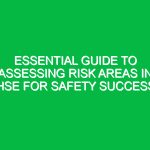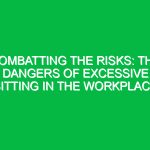Introduction
In an increasingly safety-conscious world, the relevance of Atex EN standards cannot be overstated, especially within the Health, Safety, and Environment (HSE) domain. Atex, or the ATmosphères EXplosibles directive, refers to a European Union directive that focuses on equipment and protective systems intended for use in potentially explosive atmospheres. Understanding Atex EN standards is crucial for organizations that aim to maintain compliance, enhance workplace safety, and protect their employees from hazardous conditions.
Industrial settings, particularly those involving flammable materials, present unique risks. The proper application of Atex EN standards can significantly reduce these risks, ensuring that businesses not only comply with legal requirements but also foster a culture of safety. This article will delve into the intricacies of Atex EN standards, exploring their significance within the HSE framework, the key components of compliance, and best practices for implementation.
Understanding Atex EN Standards
The Basics of Atex EN
Atex EN standards encompass a broad range of regulations aimed at minimizing the risks associated with explosive atmospheres. These standards are categorized into two main directives:
- Atex Directive 2014/34/EU: This directive focuses on equipment and protective systems for use in explosive atmospheres.
- Atex Directive 1999/92/EC: This directive outlines minimum requirements for improving the health and safety protection of workers potentially at risk from explosive atmospheres.
These directives establish guidelines for manufacturers and employers to ensure that equipment used in potentially explosive environments meets stringent safety standards.
Relevance to HSE Compliance
Atex EN standards are integral to HSE compliance as they provide a framework for identifying and mitigating risks associated with hazardous environments. Compliance with these standards helps organizations avoid costly accidents and regulatory penalties while promoting a safe work atmosphere. Moreover, adherence to Atex EN standards demonstrates a commitment to safety, which can bolster a company’s reputation and improve employee morale.
Key Components of Atex EN Standards
Risk Assessment
A thorough risk assessment is the cornerstone of Atex EN compliance. Organizations must evaluate their work environments to identify potential explosive atmospheres. This involves:
- Identifying sources of ignition.
- Assessing the presence of flammable substances.
- Determining the likelihood of explosive atmospheres forming.
The outcomes of this assessment inform the selection of appropriate equipment and safety measures.
Equipment Classification
Equipment used in explosive atmospheres must be classified according to its level of protection. Atex EN standards categorize equipment into three zones based on the frequency and duration of explosive atmospheres:
- Zone 0: Areas where explosive atmospheres are present continuously or for long periods.
- Zone 1: Areas where explosive atmospheres are likely to occur in normal operation.
- Zone 2: Areas where explosive atmospheres are not likely to occur but may do so in abnormal conditions.
Understanding these classifications is critical for selecting the right equipment and ensuring compliance.
Marking and Documentation
Atex-compliant equipment must be clearly marked to indicate its suitability for use in explosive atmospheres. This includes specific symbols and codes that convey important information about the equipment’s classification and level of protection. Additionally, thorough documentation must be maintained, detailing the risk assessments, equipment specifications, and safety measures implemented.
Training and Competence
Employee training is a vital aspect of Atex EN compliance. Workers must understand the risks associated with explosive atmospheres and the proper use of safety equipment. Regular training sessions can help reinforce safety protocols and ensure that employees are competent in identifying hazards and responding appropriately.
Potential Hazards and Safety Considerations
Identifying Common Hazards
Industries that often deal with explosive atmospheres include oil and gas, chemicals, pharmaceuticals, and food processing. Common hazards in these environments include:
- Flammable gases and vapors.
- Dust generated from materials such as grain or coal.
- Static electricity and electrical equipment.
Recognizing these hazards is the first step toward mitigating risks and enhancing safety.
Implementing Safety Measures
To minimize risks associated with explosive atmospheres, organizations should implement comprehensive safety measures, including:
- Using explosion-proof equipment.
- Employing effective ventilation systems to disperse flammable vapors.
- Regularly inspecting and maintaining safety equipment.
These practices can significantly reduce the likelihood of accidents and ensure compliance with Atex EN standards.
Regulations and Standards Governing Atex EN
European Regulations
Atex EN standards are rooted in European legislation, primarily the Atex directives mentioned earlier. Compliance with these regulations is mandatory for businesses operating in the EU. Failure to adhere to Atex EN standards can result in severe penalties, including fines and operational shutdowns.
National Regulations
In addition to EU directives, individual countries may have their own regulations that complement Atex EN standards. Understanding the local legal landscape is essential for organizations to ensure comprehensive compliance. For example, in the UK, the Health and Safety Executive (HSE) oversees gas safety and enforces regulations that align with Atex EN standards.
Best Practices for Atex EN Compliance
Establishing a Safety Culture
Promoting a safety culture within an organization is critical for effective Atex EN compliance. This involves fostering an environment where safety is prioritized, and employees are encouraged to report hazards or suggest improvements. Leadership should lead by example, demonstrating a commitment to safety at all levels.
Regular Audits and Reviews
Conducting regular audits of safety practices and equipment is essential for maintaining compliance with Atex EN standards. These audits should assess the effectiveness of existing safety measures, identify areas for improvement, and ensure that employees are adhering to safety protocols.
Engaging with Experts
Consulting with Atex experts can provide valuable insights into compliance strategies and best practices. These professionals can offer guidance on risk assessments, equipment selection, and training programs, helping organizations navigate the complexities of Atex EN standards.
Conclusion
Atex EN standards play a crucial role in ensuring safety within industries that operate in potentially explosive environments. Understanding these standards is not merely a legal obligation; it is a commitment to protecting employees and fostering a culture of safety. By conducting thorough risk assessments, implementing appropriate safety measures, and promoting ongoing training, organizations can effectively comply with Atex EN standards while minimizing risks.
As industries continue to evolve, the importance of Atex EN compliance will only grow. Organizations must remain vigilant, adapting to new challenges and ensuring that safety remains at the forefront of their operations. By doing so, they not only safeguard their workforce but also contribute to a more sustainable and responsible industrial landscape.


